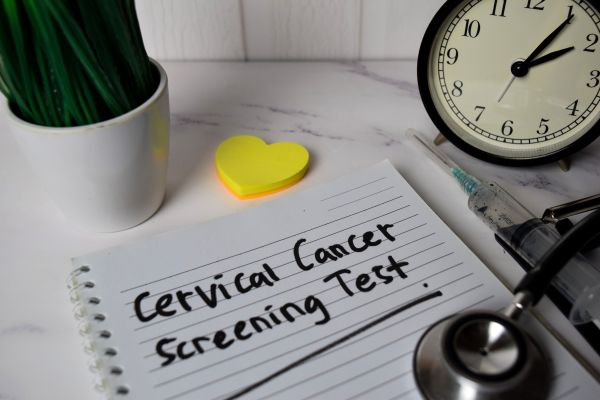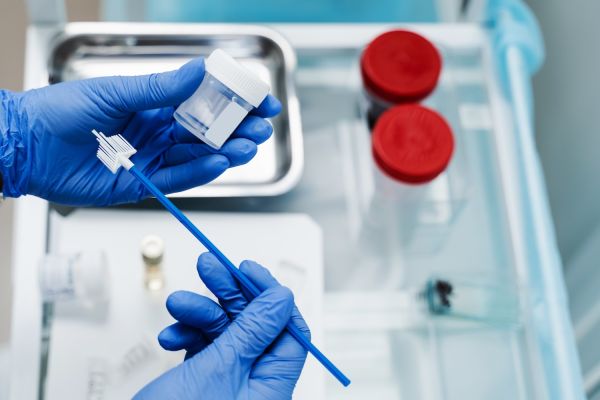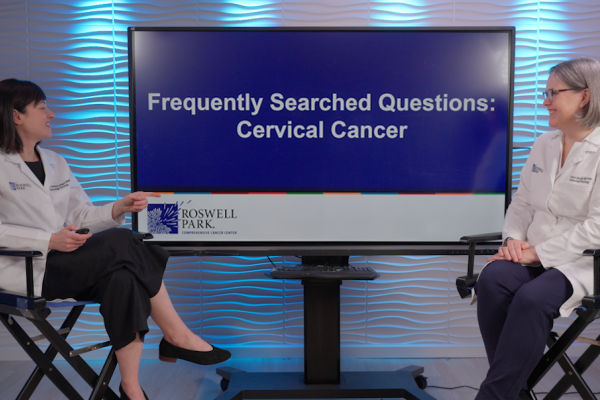Cervical screening is easy and the best way to prevent cancer.
Cervical dysplasia is a potentially precancerous condition caused by abnormal cells that form on your cervix. The condition may range from mild to severe. However, if left untreated, severe cervical dysplasia may eventually lead to cervical cancer.
“The risk of cervical dysplasia turning into cancer is determined by the severity of dysplasia and other risk factors such as the age of the patient and how long the dysplasia has been present,” explains Peter Frederick, MD, FACOG, Clinical Chief of Gynecology at Roswell Park Comprehensive Cancer Center. “For mild or low-grade dysplasia, the risk of progressing to cancer is only about 1%. For severe or high-grade dysplasia, the risk of cervical cancer developing may be as high as 40% without treatment.”
In people assigned female at birth, your cervix is the lowest part of the uterus that connects to your vagina. Cervical dysplasia happens most often among women who are of childbearing age, between 25 to 35 years old.
What causes cervical dysplasia?
While there may be some exceptions, cervical dysplasia is usually caused by exposure to the human papillomavirus (HPV), a sexually transmitted disease. There are more than 100 strains of HPV. Some of these – such as HPV-16 and HPV-18 – are more likely to infect your reproductive tract and cause cervical dysplasia.
While HPV infection is the most common cause of cervical dysplasia, the majority of people exposed to HPV never develop the precancerous condition. In addition to HPV infection, other risk factors for developing cervical dysplasia include:
- Being over age 55. HPV infections can last longer in people over 55, and often clear more quickly in people 25 or younger.
- Smoking cigarettes. Smoking and using other tobacco products generally doubles the risk of cervical dysplasia.
- A weakened immune system. Immunosuppressant drugs or medical conditions that suppress the immune system like HIV can make it harder for your body to fight HPV, as well as other infections.
- Having multiple sexual partners.
- Being sexually active before age 16.
- Having a partner whose previous partner had cervical cancer.
- Genital warts.
What are the symptoms of cervical dysplasia?
Cervical dysplasia is usually discovered as the result of your routine Pap test. There are generally no noticeable symptoms, but if symptoms do occur, you may experience:
- Abnormal vaginal discharge
- Spotting between menstrual periods
- Bleeding after sexual intercourse
- Painful sex
- Bleeding during menopause
“It’s important to stress that cervical dysplasia is generally asymptomatic — by the time symptoms develop it could be more advanced or even cancer. That’s why it’s critical to get regular screening as recommended by your healthcare provider, so any dysplasia can be identified and treated before symptoms occur,“ Dr. Frederick advises.
How is cervical dysplasia diagnosed?
Your doctor typically uses a Pap test to determine if there are any abnormal cells on your cervix. The procedure uses a plastic or metal instrument, called a speculum, to look inside your vagina and collect a few cells and mucus from the cervix and the area around it. The cells are sent to a laboratory for examination under a microscope.
Although there may be exceptions to these guidelines based on individual circumstances, healthy women are advised to get a Pap test every three years beginning at age 21 through age 29, and healthy women aged 30 through 65 may also be encouraged to get a Pap test every three years – or a Pap test with HPV testing every five years.
Not all abnormal pap tests or positive HPV results indicate that cervical dysplasia is present. Cervical dysplasia is confirmed by a cervical biopsy (taking a small piece of cervical tissue) that is often done at the time of colposcopy (kol-POS-kuh-pee), which involves looking at the cervix with a special magnifying device.
What is the treatment for cervical dysplasia?
The severity of your condition, your age, general health and personal preferences will help you and your doctor determine what treatment is best for you. Treatment usually involves removing the abnormal cells from the cervix, and some procedures can impact future pregnancies.
If you are diagnosed with mild, or low-grade cervical dysplasia – cervical intraepithelial dysplasia (CIN 1) – your doctor may decide to take a wait-and-watch approach to treatment. You may be advised to take another Pap test to see if the abnormal cells have cleared on their own, or if further evaluation with colposcopy is necessary.
Similar to a Pap test, a colposcopy is a procedure that uses a special instrument to closely examine your cervix, vagina and vulva for signs of disease. If your Pap test is abnormal, your doctor may use a colposcope to look for certain changes in cervical and vaginal tissues, such as abnormal blood vessels, tissue structure, color and patterns.
For individuals with moderate-to-high-grade cervical dysplasia (CIN 2 or CIN 3), treatment is necessary. However, for people considering having children in the future, usually in age range 21 to 24, moderate cervical dysplasia can be monitored with a Pap test and colposcopy every six months for up to two years as long as there is no evidence of worsening abnormalities.
When treatment is indicated, your physician may perform one of the following options described below. Moderate and severe cervical dysplasia are most often treated with LEEP or cold knife conization of the cervix.
- Cryotherapy – freezes abnormal cells.
- Laser ablation – vaporizes abnormal cells with a CO2 laser.
- Loop electrosurgical excision procedure (LEEP) – surgically removes a cone-shaped portion of the cervix using a wire loop.
- Cold knife conization – similar to a LEEP, except a scalpel is used instead of the loop to remove the bottom portion of the cervix, and a conical portion of the center of the cervix.
- Hysterectomy – surgically removes the entire cervix and uterus.
How can I help prevent cervical dysplasia?
Generally, it takes up to 10 years for untreated cervical dysplasia to develop into cancer, which is why healthcare providers recommend keeping up with your Pap tests and HPV screening.
“It is extremely important to keep current with cervical cancer screening, Pap and/or HPV tests, because it is a safe, easy, and effective method to prevent cancer. Although there may be exceptions that you should discuss with your healthcare provider, current guidelines typically recommend screening for women aged 21-65,” says Dr. Frederick.
Although women younger than 21 can still develop cervical dysplasia, the risk of cervical cancer at this age is exceedingly rare and most cervical dysplasia will resolve without treatment. In low-risk women older than 65 who have been current with negative screening or in women who have had their cervix removed as part of a hysterectomy, continued pap tests are often not recommended due to the low risk of cervical cancer.
If you have a diagnosis of cervical dysplasia, seek a consultation at Roswell Park, or a second opinion after an abnormal Pap taken at another location. Our expert pathologists and cytopathologists will review the results, and having an expert set of eyes on your test results ensures that you get an accurate diagnosis.
Why Roswell Park for cervical dysplasia and cervical cancer?
At Roswell Park, our team of board-certified gynecologic oncologists, pathologists, cytopathologists and radiation oncologists have years of advanced training and experience working together to successfully treat and prevent cervical cancer and cervical dysplasia. We would be honored to use our expertise to help you or your loved one impacted by cervical cancer or dysplasia.
“Benefits our team can provide include comprehensive counselling on how this diagnosis may impact quality of life or future fertility, applying the latest studies and medical knowledge to your specific situation, providing reassurance that you are on the right track with your treatment, access to cutting edge clinical trials not available elsewhere, and of course excellent clinical and surgical outcomes that result from treating a high volume of patients as part an integrated team," Dr, Frederick says.
Why Roswell Park for cervical cancer?
We provide multidisciplinary cancer care that integrates the expertise from several specialists, including gynecologic and radiation oncologists, dietitians, physical therapists, psychologists and more.
Learn more



